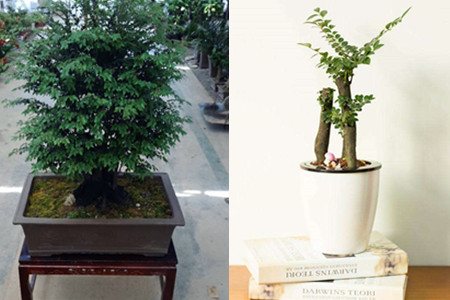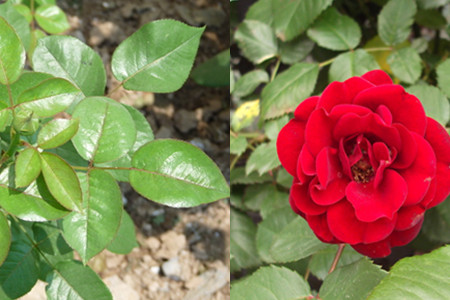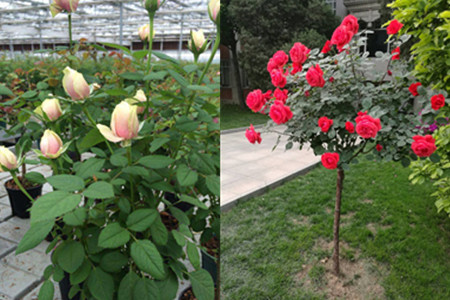How to raise a few key points of lobular red sandalwood bonsai to raise valuable potted plants

Red sandalwood is the first mahogany, lobular red sandalwood is the leader of red sandalwood, so it is of great value. Lobular red sandalwood is called a gift from heaven in Buddhist sutras, which has the function of detoxifying, repelling evil spirits and improving fengshui, so potted plants are not only used for ornamental purposes. As the saying goes, one inch of red sandalwood and one inch of gold, what are the skills of such a valuable plant culture? Let's talk about it in detail.
First, temperature requirements.
Lobular red sandalwood is a tropical plant from India, adapted to the temperature and climatic conditions of Southeast Asia, so like the sun, can not adapt to low temperature environment. The culture temperature of lobular red sandalwood is between 20 and 30 degrees Celsius, which is easy to freeze if it is lower than 3 degrees Celsius. Spring, summer and autumn can be raised in an outdoor environment, but they should be moderately shaded in summer and kept indoors in winter to avoid low temperatures.
In general, people like to put potted plants in the study or in the living room, where there is no direct sunlight, which is not suitable for the growth of plants that like the sun. Lobular red sandalwood in this environment for a long time will grow, the branches are getting longer and longer, the shape is not beautiful, because to put in a sunny position.
Second, how to water.
Lobular red sandalwood has a high demand for moisture, so it is a drought-intolerant tropical plant, so it needs to be watered once in two or three days. Lobular red sandalwood watering is skillful, watering should be thoroughly watered, but be careful that there can be no stagnant water in the basin. It can not be watered at noon when the sun is direct and the temperature is high. The evaporation of water vapor caused by high temperature will wither and kill the green plants. Lobular red sandalwood likes a more humid environment, you can use a spray can spray foggy water to create a humid environment.
Many friends breeding lobular red sandalwood bonsai can not grasp the timing and amount of watering, resulting in green plants lack of water, the following talk about how to deal with it.
1. How to deal with the initial stage of water shortage.
When you find that the bonsai branches are sagging, it shows that it is short of water. This state shows that green plants are relatively easy to deal with at the initial stage of water shortage, as long as they are watered once in the morning and once in the evening.
2. How to deal with the drying of young shoots caused by serious lack of water.
When the lack of water is serious, it will be found that the leaves of lobular red sandalwood are semi-withered, and the tender branches that have just grown become dry. At this time, you should trim off the dry branches, seal the wound with paint or wax, put the bonsai in a cool place, wait for it to sprout slowly, and pay attention to watering.
3. How to deal with the main trunk caused by water shortage.
When the water loss of bonsai is very serious, what if the trunk has dried up? The dry trunk should be cut off, after sealing the wound, the whole bonsai should be put in water to replenish water. Wait until the bonsai absorbs enough water and put it in a cool place to bring it back to life.
Third, how to apply fertilizer.
Lobular red sandalwood root system is more developed, and its own parasitic nodules have nitrogen fixation, so the requirement for the soil is not high, do not need frequent fertilization, you can dilute the green plant nutrient solution every other month and pour it into the soil with water.
Because of the particularity of its well-developed root system, leaflet red sandalwood pot culture can not directly replace flower soil with nutritious soil, nor should it bury nutrient fertilizer directly in the soil, which will damage the root system. Too much nutritious soil and fertilizer will also burn roots, which is disadvantageous.
Fourth, do not change the location of potted plants at will.
When your lobular red sandalwood grows well and has adapted to the existing environment, don't move the flowerpot at will, otherwise it will increase the growth burden.
These are the nursing skills of lobular red sandalwood, especially to remind you that red sandalwood is expensive and there are many imitation goods in the market. Please identify the authenticity before you buy it.
Into the Indian lobular red sandalwood bonsai red sandalwood, also known as chicken blood red sandalwood, ebony, green dragon wood. Mostly produced in tropical and subtropical primeval forests. Mainly in the Indian state of Mysore, other types of sandalwood are classified as grass pear wood. Lobular sandalwood grows slowly and takes hundreds of years to grow into plant. the largest red sandalwood is only about 20 centimeters in diameter. At the end of the Ming Dynasty, the rosewood in all parts of Nanyang was almost cut down, and all the rosewood used in the Qing Dynasty were collected in the Ming Dynasty, which is an important reason why red sandalwood is cherished by the world. Lobular red sandalwood is a plant of the genus Sandalaceae, and Indian red sandalwood is the best. The earliest record of red sandalwood is Jin Cuibao's "Ancient and Modern Notes", which is called "Rosewood, out of Funan, purple, also known as red sandalwood." Lobular sandalwood grain is not obvious, the color is orange at the beginning, for a long time is dark purple such as paint, almost can not see the annual wheel pattern. The vascular lines are very fine and twisted like cow hair. And lobular red sandalwood is also a valuable traditional Chinese medicine, recorded in the Compendium of Materia Medica, red sandalwood can stop bleeding, relieve pain and regulate qi and blood. About the conservation of red sandalwood: lobular red sandalwood is a tropical plant, which has high water requirements and is not resistant to drought, so it should be watered once every two or three days. Watering is also skillful, not just a basin of water. Watering can not be carried out at noon when the sun is the most poisonous, this can easily lead to high-temperature moisture evaporation of plants, more times will lead to plant withering and death. When watering, you should water thoroughly, not just wet the surface. The parasitic root nodules of lobular red sandalwood have the effect of nitrogen fixation, so there is no need to apply fertilizer frequently. Drop the plant nutrient solution into the water for one or two months and pour it on the soil. Pot fertilization should not forget to bury the nutrient soil in the soil, especially when the plant growth has been stable, the root system goes deep into the soil, a large area of moving soil will hurt the plant root system, and burying a large amount of nutrient soil may burn the root because the soil is too fertile, resulting in plant root damage. Price of Lingnan bonsai
The following is a brief introduction of some Lingnan bonsai market price information for reference:
(1) Lingnan send sparrow plum boutique pile view large living room courtyard green plant pot, reference price: 48000 yuan / pot.
(2) leaflet red sandalwood pile bonsai Lingnan pie, reference price: 488 yuan / pot.
(3) Lingnan School of bonsai, valuable trees, reference price: 1088 yuan / pot.
- Prev

Rose water has three symptoms to deal with in time.
Rose, also known as moon red, rose flower, is an evergreen semi-evergreen low shrub of Rosaceae. It blooms all the year round. It is generally red, or pink, occasionally white and yellow. It can be planted as an ornamental plant or as a medicinal plant.
- Next

What are the points for attention of rose grafted rootstocks?
The common courtyard roses in real life are grafted, which can improve the variety and facilitate viewing and management. Which rootstocks are generally selected for rose grafting? What do you need to pay attention to in grafting? Let's introduce it in detail.
Related
- Fuxing push coffee new agricultural production and marketing class: lack of small-scale processing plants
- Jujube rice field leisure farm deep ploughing Yilan for five years to create a space for organic food and play
- Nongyu Farm-A trial of organic papaya for brave women with advanced technology
- Four points for attention in the prevention and control of diseases and insect pests of edible fungi
- How to add nutrient solution to Edible Fungi
- Is there any good way to control edible fungus mites?
- Open Inoculation Technology of Edible Fungi
- Is there any clever way to use fertilizer for edible fungus in winter?
- What agents are used to kill the pathogens of edible fungi in the mushroom shed?
- Rapid drying of Edible Fungi

